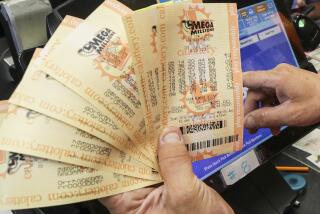State lottery to up the ante with its first raffle
- Share via
SACRAMENTO — A favorite money-raiser of churches and school clubs, the raffle goes big time next month when the California Lottery launches a game with million-dollar prizes.
Modeled after a raffle held by the Pennsylvania Lottery in 2005 and copied by 10 other states since, the California Lottery raffle is expected to generate $7 million to $8 million for public schools in a 40-day spurt of ticket-buying.
Tickets go on sale Feb. 5 and will be available until 6 p.m. on St. Patrick’s Day, March 17. An hour later, the lottery will choose up to 10 $1-million winners, depending upon a formula based on how many tickets have been sold.
It’s the latest gamble by lottery officials in their never-ending quest to energize players and boost payments to schools, which get 34% of the revenue. Last year, the lottery generated $3.58 billion in sales and gave $1.26 billion to schools, the highest in its 22-year history. By law, the lottery can spend no more than 16% on administrative costs.
“This is the latest idea,” said I. Nelson Rose, a Whittier Law School professor and expert on gambling. State lotteries are hamstrung, he said, because although they are a retail business, they are also government agencies, and they typically plow only 50% of sales back into prizes, much less than private gambling operations.
“In Nevada, even the worst slot machine has to give 85% back,” said Rose, “and because of competition there’s probably no slot machine that gives back less than 90%.”
Lottery officials expect the raffle to attract people who don’t typically play lottery games. They figure most people are familiar with the concept of a raffle -- buy a ticket, get a number, win a prize if your number gets drawn -- from ubiquitous local fundraisers.
“There’s not a lot of rules you have to figure out,” said acting Lottery Director Joan M. Borucki. “It’s ... probably the best odds of any game we’ve offered at the lottery.”
Lottery officials hope to sell 5 million raffle tickets, each with a seven-digit number from 0000001 to 5000000. The numbers will be issued in sequence by a central computer -- players can’t pick numbers -- and cost $5 each or five for $20. There is no limit to how many tickets a person can buy.If all 5 million tickets are sold, 10 $1-million prizes will be awarded, and the odds of winning a million dollars in the raffle will be 1 in 500,000. That compares with the 1-in-175,711,536 odds of winning Friday’s $43-million Mega Millions jackpot or the 1-in-600,000 odds of winning $100,000 with a $5 “Lucky Times 20” Scratchers ticket.
To encourage players to buy early, the lottery will conduct preliminary drawings for 10 $10,000 winners on Feb. 17, Feb. 24, March 3 and March 10. Winners on those days are still eligible for the $1-million prizes.
Rose said the raffle might prove popular because it’s got an “Oh, I was so close” element for people as the seven winning numbers are drawn.
To sustain interest in gambling, he said, “requires a near miss.”
The Pennsylvania Lottery has held two more raffles since its first on New Year’s Eve 2005, selling 625,000 tickets at $20 each. Each featured five top prizes of $1 million.
“Every one of our raffles we’ve sold out two weeks before the deadline,” said Pennsylvania Lottery spokeswoman Elizabeth Brassell.
The three lotteries netted more than $14 million to fund senior citizen programs.
“We were looking for something we could drop in every once in a while to enhance our product lineup and boost our bottom line,” she said.
The South Carolina Education Lottery fell short of high expectations with its first raffle last fall. The state -- with a population of 4.2 million -- set a goal of selling 1 million $10 tickets, but sold about 900,000.
“We’re looking at launching it again,” said spokeswoman Tara Robertson, “maybe being not as aggressive with the number of tickets we sell.”
Most state lotteries charge $20 for raffle tickets, but the California Lottery won’t charge more than $5, Borucki said, because players here are not accustomed to spending $20 for a single lottery ticket.
“Other states for years have sold Scratcher tickets that are $20,” she said. “We didn’t really want to go beyond what was the norm for California.”
Lottery staff think the raffle will generate up to $23 million in sales and at least break even when 2 1/2 million tickets are sold. If it is successful, Borucki said, more raffles will be held.
More to Read
Sign up for The Wild
We’ll help you find the best places to hike, bike and run, as well as the perfect silent spots for meditation and yoga.
You may occasionally receive promotional content from the Los Angeles Times.






